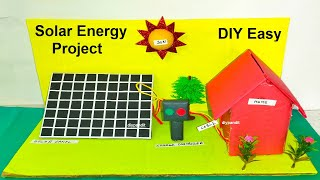In this post article we write about how to utilize the solar energy using solar panel to generate the solar power for the house depicted in the working model making science project
#solarenergy #solarpanel #solarpower #scienceproject #diy #physics #diypandit #modelmaking #solarenergysystem #scienceexhibition #sciencefair

Creating a solar energy model using cardboard and color paper is a great way to demonstrate how solar energy can be harnessed and utilized in a small-scale setup.
This model will include a solar panel, a house (representing energy usage), a solar controller (to regulate energy flow), and the sun (as the energy source).
Here’s a step-by-step guide to making this model:
Materials Needed
- Cardboard
- Color paper (green for grass, blue for sky, yellow/orange for sun)
- Scissors
- Glue or tape
- Marker
- Ruler
- Small LED or light bulb (optional, for demonstrating energy usage)
- Solar panel (you can create one using cardboard and aluminum foil)
- Small box or miniature house figure (to represent the house)
- Small switch or lever (to simulate energy usage)
- Small cardboard box (for solar controller)
- Small pieces of wire
- Transparent plastic sheet (optional, for covering the solar panel)
Step by Step Instructions on making of Solar energy project
1. Prepare the Base
- Base Setup:
- Take a large piece of cardboard to serve as the base of your model.
- Use green color paper to cover the base to represent grass.
- Use blue color paper to cover the top part of the base to represent the sky.
2. Create the Solar Panel
- Solar Panel Setup:
- Cut out a rectangular piece of cardboard to represent the solar panel.
- Cover the cardboard with aluminum foil to simulate solar cells.
- Attach small wires or strips of aluminum foil to connect the solar panel to the solar controller (later step).
- Optionally, cover the solar panel with a transparent plastic sheet to protect it.
3. Build the House
- House Setup:
- Use a small box or create a miniature house figure using cardboard.
- Place the house on the grassy part of the base.
4. Make the Solar Controller
- Solar Controller Setup:
- Use a small cardboard box to represent the solar controller.
- Cut out holes or slots for wires to connect from the solar panel to the house (load).
- Label the box as “Solar Controller” using a marker.
5. Add the Sun
- Sun Setup:
- Cut out a large circle from yellow or orange color paper to represent the sun.
- Place the sun in the sky section of the base, above the solar panel.
6. Wiring and Connections
- Connect Solar Panel to Solar Controller:
- Use small pieces of wire or strips of aluminum foil to connect the solar panel to the solar controller.
- Ensure the connections are secure and insulated with tape if necessary.
- Connect Solar Controller to House (Load):
- Connect wires from the solar controller to the house (load).
- This connection simulates the transfer of energy from the solar panel to the house.
Assembly and Presentation
- Arrange and Secure:
- Arrange all components (solar panel, house, solar controller, sun) on the base in a logical and appealing manner.
- Securely glue or tape each component to the base to prevent movement.
- Label and Explain:
- Use a marker to label each component (solar panel, house, solar controller, sun).
- Attach a small card or label explaining how solar energy is generated, transferred, and utilized in the model.
- Interactive Features:
- Optionally, make the solar panel adjustable to demonstrate how solar energy production changes with sun angle (use a small stand or protractor).
Testing and Demonstration
- Place in Sunlight:
- Position the model in direct sunlight or under a bright light source to demonstrate solar energy conversion.
- Observe how the solar panel absorbs light and transfers energy to the house.
- Operate Energy Usage Simulation:
- Toggle the switch or lever to simulate energy usage in the house.
- Explain how excess energy can be stored or returned to the grid (if applicable to your model).
By following these steps, you’ll create an informative and visually appealing solar energy model using cardboard and color paper. This project not only demonstrates the principles of solar energy but also encourages hands-on learning and understanding of renewable energy concepts.

